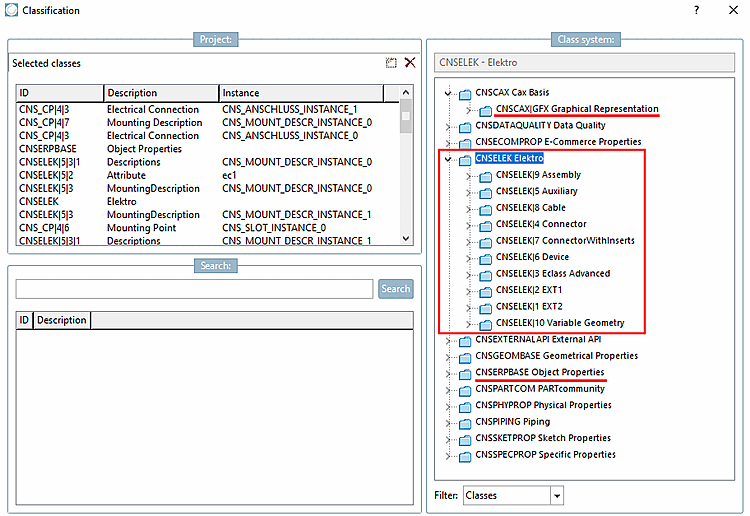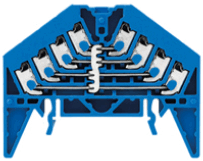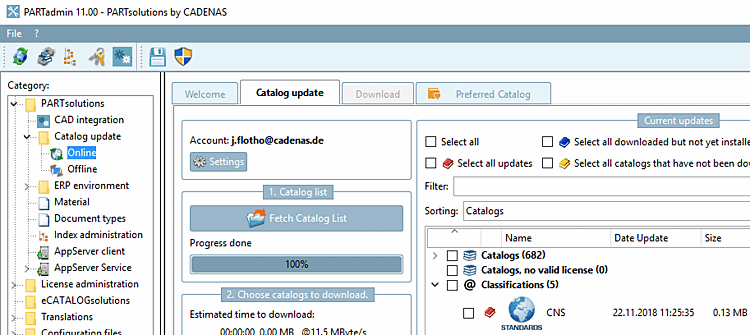- 5.12.9.1. Align component
- 5.12.9.2. PCF: Carbon Footprint 1.0 [CNSELEK|5|12|1]
- 5.12.9.3. Classification according to IEC Code 81346_2
- 5.12.9.4. Classification of Electrical Connections [CNS_CP|4|3])
- 5.12.9.5. Other CAx connection types
- 5.12.9.6. Plug connections CNS_CP|4|8
- 5.12.9.7. Rated values of electrical parts and individual connections
- 5.12.9.8. Classification according to CAX basis
- 5.12.9.9. Restricted Area [CNS_CP|4|15|2]
- 5.12.9.10. Labeling Area [CNS_CP|4|15|1]
- 5.12.9.11. Mounting grid [CNS_CP|4|15|3]
- 5.12.9.12. ECAD assemblies - Control cabinets
- 5.12.9.13. Functional definitions (electrical)
- 5.12.9.14. Symbol representations (Circuit symbols) "Advanced"
- 5.12.9.15. Using symbol libraries
- 5.12.9.16. Classify Mounting Points (Mounting Point [CNS_CP|4|6] and Mounting Description [CNS_CP|4|7])
- 5.12.9.17. Classification of assembly areas and assembly lines [CNS_CP|4|6]
- 5.12.9.18. Products with variable geometry / semi-finished products [CNSELEK|10|1 (Cable Duct), CNSELEK|10|2 (Mounting Rail), CNSELEK|10|3 (Bus Bar)]
- 5.12.9.19. Classification of cables
- 5.12.9.20. Classification of general connections / Subcircuits
- 5.12.9.21. Accessory parts (Associated Part [CNSELEK|5|4])
- 5.12.9.22. Visualization of collision rooms generated from classification data
- 5.12.9.23. General rules
- 5.12.9.24. Additional information
- 5.12.9.25. Provided CNS classes
- 5.12.9.26. Mapping between eCl@ss and CNS classification
- 5.12.9.27. Classify electrical parts: Additional modules
- 5.12.9.28. Classification certification levels
- 5.12.9.29. Article data Multi CAE - depending on product type
- 5.12.9.30. Classify Electrical Parts - Tutorial
- 5.12.9.30.1. Connection points in general
- 5.12.9.30.2. Defining the device orientation
- 5.12.9.30.3. Device type determination
- 5.12.9.30.4. Set Electrical Connections (CNS_CP|4|3) exemplified with a terminal
- 5.12.9.30.5. Class "Electrical Connection" (CNS_CP|4|3) -> Attribute "Connection EclassSymbolMap"
- 5.12.9.30.6. Electrical Connection" class (CNS_CP|4|3) -> "Connection name equivalences " feature
- 5.12.9.30.7. Special features for plugs
- 5.12.9.30.8. Mounting Description (CNS_CP|4|7)
- 5.12.9.30.9. Mounting Point (CNS_CP|4|6)
- 5.12.9.30.10. Associated Part [CNSELEK|5|4]
- 5.12.9.30.11. Testing in PARTdataManager
- 5.12.9.30.12. Most frequent error sources
- 5.12.9.31. NX: Routing Electrical
![[Note]](https://webapi.partcommunity.com/service/help/latest/pages/jp/3dfindit/doc/images/note.png) | Note |
|---|---|
This chapter's focus is on using the CNS classification. That target systems additionally need to be classified according to eClass in order to identify the part type, remains untouched by this. Within the CNS classification, in addition to the labeling with specific electrical classes (CNSELEK [component level] or CNS_CP|4 [connection points]), the labeling with classes for determining the graphical representation (CNSCAX|GFX) or material characteristic properties (CNSERPBASE [see Section 5.12.3.1, “Classification (CNS) ”]) is also important, to name just a few.
| |
In the field of electrical engineering not only the outer shape of a component is decisive: In fact, engineers need further information, especially connection information, when looking for an appropriate part. In order for electrical components to be properly exported in respective ECAD target systems, they have to be classified accordingly.
Some classes refer to the component as a whole, others to specific areas such as electrical connections or plug connections. When classifying, this is reflected in the choice of filter such as classes [Classes] or connection points [Connection points].
Part classifications such as article number, descriptions and IEC code 81346_2, for example (see Section 5.12.9.3, “Classification according to IEC Code 81346_2”)
![[Note]](https://webapi.partcommunity.com/service/help/latest/pages/jp/3dfindit/doc/images/note.png)
Note Appropriately positioned connection points must already exist.
A connection point can fulfill different tasks, that's why classification for electrical CADs (ECADs) is decisively.
[a]Electrical Connection (CNS_CP|4|3)
On this see Section 5.12.9.4, “Classification of Electrical Connections [CNS_CP|4|3])”.
Elektro Alignment Coordsys (CNS_CP|4|5)
On this see Section 5.12.9.1.1, “ Set connection point ”.
Depending on class, very different values have to be entered for the specification of points. So it makes a big difference, if a borehole diameter or a stripping length is specified, for example.
Feature
CNS_CP|4|2::000008001applies to the drill hole diameter, whileCNS_CP|4|3::000036001applies to the stripping length.General rules for classifying can hardly be found, because each supplier prefers different definitions, for example for the position of electrical connections. Furthermore the position of electrical connections may depend on whether a stripped wire shall be plugged in or a hard metallic connector (male) [compare shockproof plug]. In the case of the below depicted terminal, which complies with the first case, the electrical connections are near the bottom.
[a] Classes meant for connection level (and not for the whole part) can be recognized by the prefix "CNS_CP".
The prerequisite for classification is a current CNS classification.
If necessary, update the CNS classification via PARTadmin -> Catalog update -> Online.





